Some helpful hints on making our make-your-own kite kits
Doesn’t matter if the kite is assembled first or painting is done first….the only 2 things to remember before deciding this are:-
– Sticky bits will NOT stick to wet paint so if you are using paints (as opposed to crayons or textas) make sure it is dried overnight before assembly and,
– kids will need to handle their kite a lot during assembly and wet paint will get all over them. Partners
Might be good to get the kids to work with a partner.
It’s easier to get the sticky bits accurately in place if someone is holding the rods for you.
Together they can make the first kite and then the second.

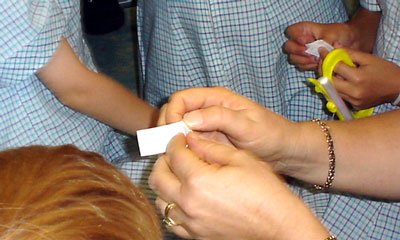
The best way we’ve found for putting the sticky bit onto the sail is:-
With the sticky bit still on the pad of your finger, place the finger on the table (sticky bit facing up) now, with the other hand, slide the edge of the sail over the sticky bit.
Once it’s accurately in place, squeeze down.
This is much easier to get accurate then holding the sail in place and sliding the sticky bit onto it. Precision
It is really, really important to make sure the kids get the sticky bit accurately in the middle of it’s correct spot.
The top, bottom and sides of the sail all have a 25mm wide flat spot, make sure the sticky bit is exactly in the middle of this flat spot and square to it, not angled.
It’s also really important that the sticky bit is half on/half off the sail. This means that, when wrapped over the rod, it has a good amount of sticky left to grip to this second side.
If you forget to tell the kids to put the Tail on before they stick the second end of the Center rod down, don’t worry, there is a cheats way to still get it on:-
The small wire ring at the end of the tail is a ‘split ring’. Just push this against the edge of the rod and the split should open up and slide onto the rod. Side pockets
Carrying a fully made kite home on the bus is a bit difficult so I’ve designed the side pockets in such a way that the kite can be dismantled and rolled up for easy transport.
Putting these side pockets on can be a bit tricky so take lots of time explaining these instructions to the kids…..lots of them get confused because this is different to what they’ve done to attach the Center rod.
Basically, all they are doing is making a pocket to slide the fiberglass between the two bits of paper.
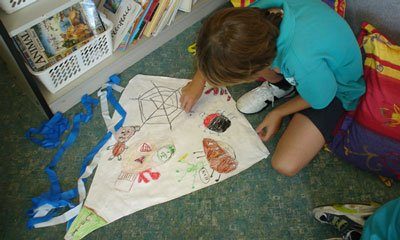
Here is the easiest way to peel the sticky tabs:-
Each one has a cloth side and a paper backing side.
With the cloth facing you, not the paper, use the pad of your first finger to pull down at the top edge of the cloth, don’t use your nail and don’t work at a corner…work at the full edge.
Once you get an edge peeling, peel the cloth away from the paper, not the other way around.
Keep the end of the sticky bit on the pad of your finger…makes the next step easier.
Another way is to fold the tab in half first. This creates a ‘bubble’ at the fold that often makes it east to separate the two sides.

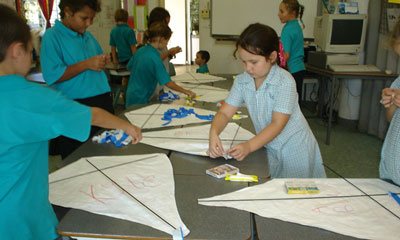
Make sure the kids have the end of the rod exactly level with the edge of the sail.
There should be no rod sticking out past the sail and definitely no sail folded over with the sticky bit because the rod was placed ‘short’ of the edge of the sail (this will cause major problems at the other end!).
Staples:
The sticky bits will lift if they get wet or if sand gets under them so it’s a good idea to put a staple either side of the rod to hold it in place.
Remind the kids that the staples should be parallel to the rod, not across it.
How long do you need to allow?
This depends on the age of the kids and the time you want to devote to art work but work on about these times.
Assembly : Allow 30 minutes.
Art : Allow at least 30 minutes.
Flying : Minimum of 30 minutes.

Now, let's go flying...
(read through our How to fly a single string kite' page for more detailed how to's)
Winds
These kites are designed to fly in light to moderate winds. If it is a really windy day, put ‘em in the storeroom and wait for another time! Both the kites and the kids will thank you for it.
Strong Winds –
If the wind is too strong there will be three consequences:-
– The kites will not lift into the sky, they will fly very close to the ground (they’re designed for light winds).
– The kites may roll to the side….any small error that the kids make in getting their kite exactly balanced will be amplified in the strong winds and the kites will roll to one side.
– The kites may break. It’s only sticky tape…..it will blow out if the pressure is too great.
Light to Moderate Winds –
In light to moderate winds, the flyers don’t need to run. Just hold the sail to the wind, let out string, and they will rise easily into the sky.
No Wind –
If the wind is so light that the kites won’t lift, get the kids to WALK. A brisk walking speed is all the kite needs to lift. but….
Everyone must walk in the same direction & that direction must be INTO whatever little breeze there is.
Where to fly
Use the biggest open space you can find. Trees and buildings will cause the wind to swirl and create uplift and downdrafts so make sure there are no obstructions within 100m upwind of the kites.
Handles
The end of the flying string is tied to the handle but the knot can come loose. Make sure the kids test the knot if they are letting out all of the string, otherwise there kite may float away.
Repairs
Take 3 things with you to the flying field:-
Extra sticky tape, a stapler and scissors.
This will save you lots of effort!
Knots
String only gets knotted if it is bunched up. Best way to avoid tangles is to have the string up in the sky to the kite or wound onto the handle.
Tell the kids not to bring in the string with their hands. This is a surefire recipe for knots!
Tangles
As Phil Collins sang “Don’t stand so close to me!”
How close is too close?
Depends on the wind but about 5m apart should be fine. The kids will need to judge this on the day but remind them to be aware of it.
If you do get a knot or tangle, just break the string, throw the knotted bit in the bin and retie the line.
Safety
Don’t let kids run the string through their fingers. It will burn and it will cut!
Don’t let kids run…if they run a kite line across someone else’s neck, arm or leg it will really hurt them.
Home time
When time has come to finish flying, get the children to wind the line in while the kite is in the sky….this keeps the string nice and straight while they wind it onto the handle. If they bring the kite down first and then try to wind it will probably end in a knot.
Tie the string into one of the slits on the side of the handle a few times to stop it unravelling.
Rolling Up
If the children made the side pockets as per the instructions they should be able to easily slip
the cross rod out of it’s two pockets, swivel it to be parallel to the centre rod and roll the kite up. Put the handle and the tail inside the sail before they start to roll.
WARNING:
DO NOT USE NEAR
OVERHEAD POWER LINES
How to make a kite...in a lot more detail!
First, check your bits…..
1 Sail 1 Handle 2 Fibreglass rods
1 tail set 4 pieces sticky cloth tape
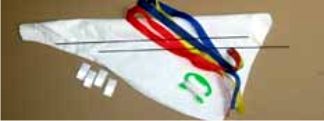
You will also need a stapler and colouring in stuff.
Ok, lets make the kite!
The Face side should be down towards the desk for this part, the students should be seeing the BACK of the sail.


The more exact it is the more stable the kite will be in flight.
Make sure the end of this rod is at the very top of the sail and fold over the remaining half of tape to stick the rod to the sail.
You can put a staple either
side of the sticky tab if you wish for extra security, but we’ve never had one come unstuck so we’ll leave this up to you.

Move to the other end of this same rod now. Slide the metal ring on the Tail onto the rod and repeat the sticking process we used at the top.
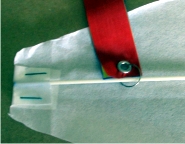
Remember, the kite flies better if the rod is exactly down the center of the sail.
or….
if you want the kids to be able to Roll their Kite Up to store it more easily,

then Connecting the Cross Rod will be DIFFERENT.
These parts can be a little tricky so please read
them carefully before attempting the steps.
We’ll use this paper to make two pockets for the cross rod .
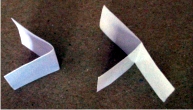

Ok, stick this peeled back part onto the FACE of the sail, at the very edge. Keeping the paper in place, fold over the rest
and staple it.
One staple either side of the middle.
This creates a pocket that the cross rod can slip in and out of to make the kite easy for the kids to roll up to carry home.
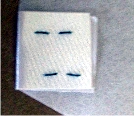
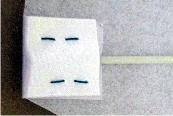
Make sure the sticky tabs are square to and exactly on the squared edge of the corner and fold it over so that the cross rod is a firm fit into the pockets…not loose but not bending either…..just right.
We now have a framed kite sail that can be easily dismantled to take home to impress Mum and Dad!
To finish the kite we just need to connect the string.

Make sure you’re going from PAINT to WHITE then back to PAINTED face.
Wrap the string diagionally around BOTH rods and feed it back through the hole and then tie off in a knot.
MAKE SURE the string wraps both rods before it comes back to the FRONT.
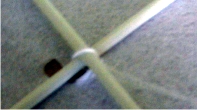
and...if the photos are a little hard to follow....
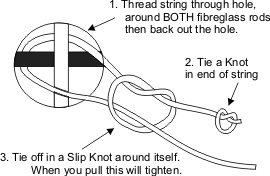
Now, decorate the sail. Use crayons, paints, textas, felts….whatever takes your fancy…..but ONLY ON ONE SIDE. Use the side where you CANNOT SEE the Rods.
If your kite looks like this……
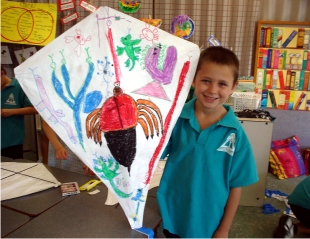
then you’re ready to fly!
Questions?
If you have any questions or concerns after reading these notes, feel free to give us a call.
We are teachers with many years experience (with both kids and kites!) and we’d be happy to help.
